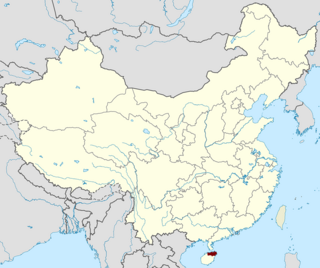Tang dynasty
| | This section is empty. You can help by adding to it. (February 2024) |
| Huainan Circuit | |||||||
|---|---|---|---|---|---|---|---|
| Chinese | 淮南 道 or 淮南 路 | ||||||
| |||||||
Huainan Circuit or Huainan Province was one of the major circuits during the Tang dynasty,Five Dynasties period,and early Song dynasty. Huainan was also the name of Wu,whose territorial claims was nearly identical to the circuit. In 1072 during the Song dynasty it was divided into 2 circuits:Huainan East Circuit and Huainan West Circuit.
Its administrative area,between the Huai River and Yangtze,corresponds to roughly the modern provinces of northern Jiangsu,northern Anhui,southern Henan and northern Hubei,with a tiny part of Jiangxi.
| | This section is empty. You can help by adding to it. (February 2024) |
| | This section is empty. You can help by adding to it. (February 2024) |
The circuit administered roughly 22 prefectures (including 1 superior prefecture and 4 military prefectures) and 71 counties. [1]
Yingzhou or Ying Prefecture (潁州) was a zhou (prefecture) in imperial China in modern northwestern Anhui, seated in modern Fuyang. During the later parts of the Qing dynasty it was known as Yingzhou Prefecture (潁州府). It existed (intermittently) from 528 until 1912.

Huazhou or Hua Prefecture was a zhou (prefecture) in imperial China seated in modern Hua County, Henan, China. It existed (intermittently) from 596 to 1374. Through history it was also known by other names, including Yan Prefecture (606–607), Dong Commandery (607–618) and Lingchang Commandery (742–758).

Yingzhou or Ying Prefecture was a zhou (prefecture) in imperial China in modern Hebei, China, seated in modern Hejian. It existed (intermittently) from 487 until 1108.
Hebei Circuit or Hebei Province was one of the major circuits during the Tang dynasty, Five Dynasties period, and early Song dynasty. During the Tang dynasty it was known as Hebei Dao (河北道), and during the Song dynasty Hebei Lu (河北路), but both dao and lu can be translated as "circuit". In 1042 it was divided into two circuits: Hebei East Circuit and Hebei West Circuit.
Bozhou or Bo Prefecture (亳州) was a zhou (prefecture) in imperial China, centering on modern Bozhou, Anhui, China. It existed (intermittently) from the 6th century until 1912.
Lizhou Circuit or Lizhou Province was one of the major circuits during the Song dynasty. It was split from Xichuan Circuit in 1001.
Jingxi Circuit or Jingxi Province was one of the major circuits during the Song dynasty. In 1072 it was divided into 2 circuits: Jingxi North Circuit and Jingxi South Circuit.

Qiongzhou or Qiong Prefecture was a zhou (prefecture) in imperial China in modern northeastern Hainan, China. It existed from 631 to 1329, but between 742 and 758 it was known as Qiongshan Commandery.

Liangzhe Circuit (997–1160s) was one of the major circuits during the Song dynasty (960–1279). Its administrative area corresponds roughly to modern Zhejiang, Shanghai, and southern Jiangsu. The fertile Yangtze River Delta lay within Liangzhe Circuit, as did Lake Tai. Liangzhe was the wealthiest circuit in Song.
Huzhou or Hu Prefecture (湖州) was a zhou (prefecture) in imperial China, centering on modern Huzhou, Zhejiang, China. It existed (intermittently) from 602 until 1912. Between 1225 and 1276 it was known as Anji Prefecture (安吉州).

Shen Lun, known as Shen Yilun before 976, was a scholar-official who successively served the Later Han, Later Zhou and Song dynasties. He was one of the Song dynasty grand councilors between 973 and 982.

Duanzhou or Duan Prefecture was a zhou (prefecture) in imperial China in modern Guangdong, China, centering on modern Zhaoqing. Duan Prefecture was a major production center of inkstones.

Fujian Circuit, also translated as Fujian Province, was one of the major circuits during the Song dynasty of imperial China. Its administrative area corresponds to roughly the modern Chinese province of Fujian.

Guangnan East Circuit or Guangnan East Province was one of the major circuits during the Song dynasty. Its administrative area corresponds to roughly the modern Chinese province of Guangdong and the special administrative regions of Hong Kong and Macau.

Guangnan West Circuit or Guangnan West Province was one of the major circuits during the Song dynasty. Its administrative area corresponds to roughly the modern provinces of Guangxi and Hainan, as well as the western part of Guangdong.

Jinghu South Circuit or Jinghu South Province was one of the circuits during the Song dynasty. Its administrative area corresponds roughly to the modern province of Hunan.

Jinghu North Circuit or Jinghu North Province was one of the circuits during the Song dynasty. Its administrative area corresponds to roughly the modern province of Hunan.

Wan'an Zhou or Wan'an Prefecture was a zhou (prefecture) in imperial China in modern southeastern Hainan, China. It existed from 662 to 1368, but between 742 and 757 it was known as Wan'an Commandery, and between 757 and 758 as Wanquan Commandery. The Song dynasty made it a military prefecture in 1074.
Xinghua Prefecture (興化軍府) was a Song dynasty military prefecture created in 979, under the administration of Fujian Circuit. It was abolished by the Mongol Yuan dynasty in 1277.

Henanfu or Henan Prefecture, also known as Luoyang, was a fu in imperial China in modern Henan, China, centering on modern Luoyang. It existed (intermittently) from 713 to 1913. During the Later Tang dynasty (923–937) it was the national capital. For most of the Tang dynasty it was known as the "Eastern Capital" (東都), and during the Northern Song dynasty (960–1127) it was known as the "Western Capital" (西京). From 1127 to 1234 the Jurchen conquerors named it Jinchang Prefecture (金昌府), also known as "Central Capital" (中京). For these reasons, Henan Prefecture was also colloquially called Luojing.